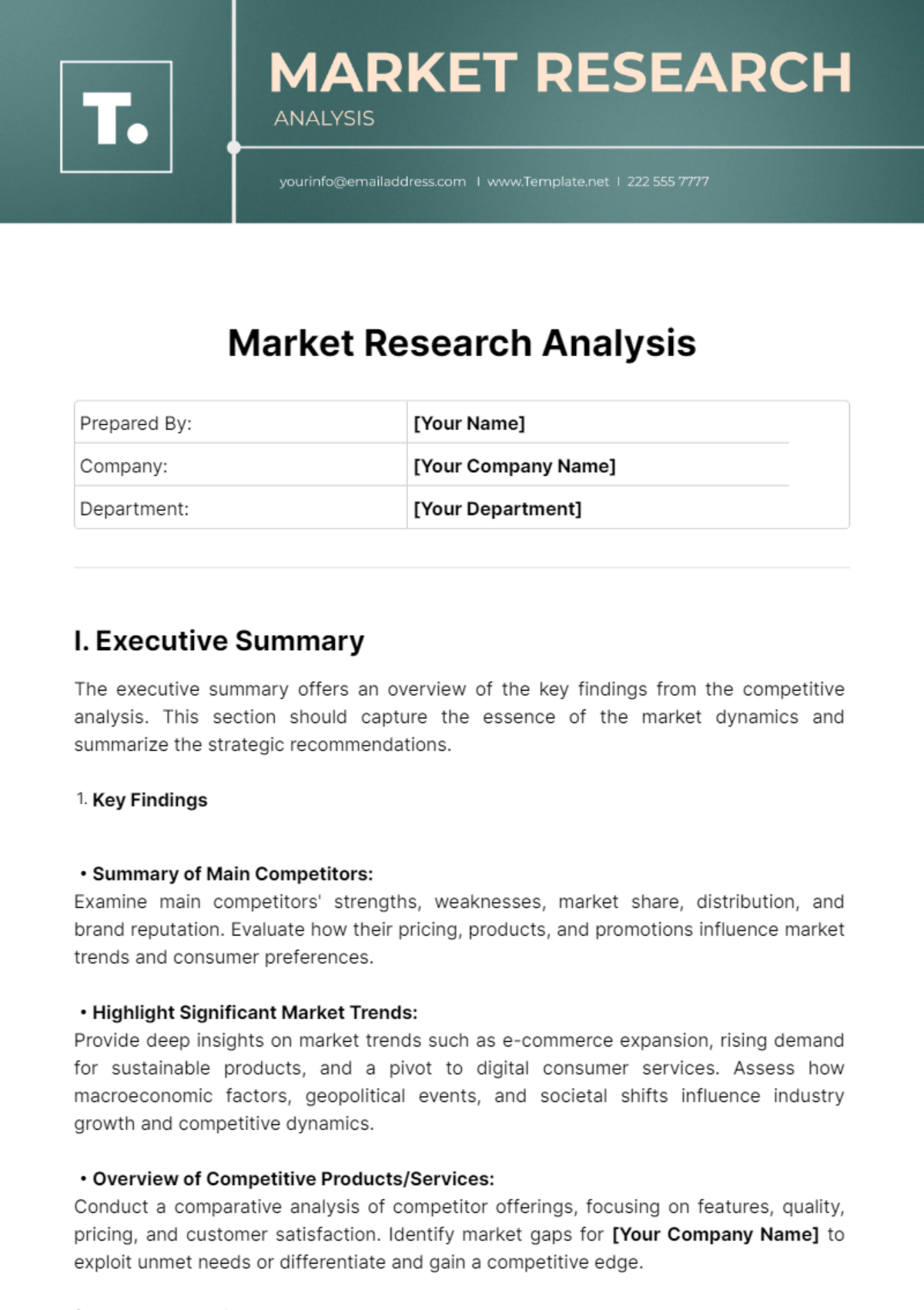Market Research Analysis
Prepared By: | [Your Name] |
Company: | [Your Company Name] |
Department: | [Your Department] |
I. Executive Summary
The executive summary offers an overview of the key findings from the competitive analysis. This section should capture the essence of the market dynamics and summarize the strategic recommendations.
Key Findings
Examine main competitors' strengths, weaknesses, market share, distribution, and brand reputation. Evaluate how their pricing, products, and promotions influence market trends and consumer preferences.
Provide deep insights on market trends such as e-commerce expansion, rising demand for sustainable products, and a pivot to digital consumer services. Assess how macroeconomic factors, geopolitical events, and societal shifts influence industry growth and competitive dynamics.
Conduct a comparative analysis of competitor offerings, focusing on features, quality, pricing, and customer satisfaction. Identify market gaps for [Your Company Name] to exploit unmet needs or differentiate and gain a competitive edge.
Recommendations
Identify Potential Areas for Market Expansion:
Analyze market segmentation data to pinpoint niche or underserved segments with strong growth prospects and assess the viability of expanding into new geographic areas, taking into account regulatory conditions, infrastructure, and cultural differences.
II. Industry Overview
Provides a broad analysis of the industry in which [Your Company Name] operates, including market size, growth rate, and key trends.
Market Size and Growth
Analyze the industry's size, growth history, and future projections. Segment the market by product, customer, and distribution to pinpoint growth opportunities and detect saturation areas.
Trends and Drivers
Examine how technological advancements, regulatory updates, and cultural changes affect consumer behavior and market trends. Investigate new developments like personalized healthcare, the sharing economy, and artificial intelligence, and their impact on the industry.
III. Competitive Landscape
This section delves into the specifics of the competitive environment, profiling major competitors and their market strategies.
A. Competitor Profiles
Competitor Name | Market Share | Key Products | Key Services |
|---|
Competitor A | 30% | Product X | Service Y |
Competitor B | 25% | Product Z | Service W |
Competitor C | 20% | Product A | Service B |
Competitor D | 15% | Product C | Service D |
B. SWOT Analysis
Strengths:
Competitor A: Strong brand equity, extensive product range, robust customer loyalty.
Competitor B: High innovation capacity, significant R&D investments.
Competitor C: Wide distribution network, reliable quality, and service.
Competitor D: Rapid growth, aggressive marketing strategies.
Weaknesses:
Competitor A: Potential complacency due to market leadership, and slower innovation pace.
Competitor B: High operational costs due to R&D expenses, and potential over-reliance on innovation.
Competitor C: Less innovative compared to leading competitors, reliance on existing products.
Competitor D: Over-dependence on aggressive marketing, possible sustainability issues of rapid growth.
Opportunities:
Competitor A: Expanding into emerging markets, diversifying product portfolio.
Competitor B: Leveraging technology for new product development, forming strategic alliances.
Competitor C: Enhancing digital presence, exploring new customer segments.
Competitor D: Expanding product lines, entering international markets.
Threats:
Competitor A: New market entrants, changing consumer preferences.
Competitor B: Technological disruptions, economic downturns.
Competitor C: Increased competition, regulatory changes.
Competitor D: Market saturation, vulnerability to economic fluctuations.
IV. Strategic Opportunities
Identification of potential opportunities for [Your Company Name] based on the competitive analysis.
A. Market Entry Strategies
Assess the attractiveness of target markets based on factors such as market size, growth potential, competition intensity, and regulatory barriers.
Evaluate market entry options, including organic growth, acquisitions, joint ventures, or strategic alliances, and develop a phased approach for market penetration.
B. Product/Service Differentiation
Conduct market research to identify customer pain points, unmet needs, and emerging trends that can inform product development strategies.
Leverage [Your Company Name]'s core competencies, such as technology expertise, brand reputation, or customer service excellence, to create unique value propositions.
V. Conclusion and Action Plan
This final section should synthesize the insights from the analysis and lay out an action plan based on the identified opportunities and threats.
A. Summary of Insights
Concise recap of the critical insights from the competitive analysis.
B. Detailed Action Plan
Define strategic objectives based on analysis.
Specify SMART goals aligned with [YOUR COMPANY NAME]'s long-term vision and short-term priorities.
Outline specific action steps, allocate resources, and establish timelines for implementation.
Assign responsibilities to cross-functional teams, set performance metrics, and regularly monitor progress to ensure the successful execution of the action plan.
Analysis Templates @ Template.net






























